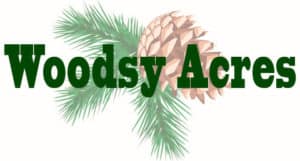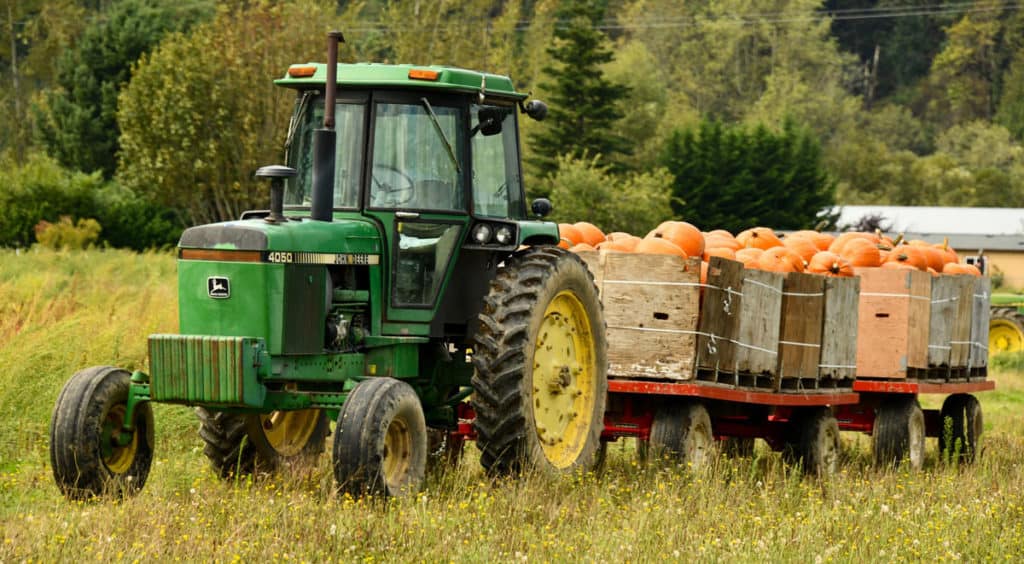
A tractor is a handy tool for completing numerous jobs that otherwise couldn’t be completed without it. With the right implements and knowledge, using them can save time and money in accomplishing many types of tasks.
Most people who own a tractor do so because they use it to save time by letting the equipment do some heavy work for them. If you own one, there are many ways a tractor can help you out, but many of these require years of practice to become competent enough before offering them as part of your services to others.
However, while maybe sharpening your skills on more complex tasks you can still offer services that you already do regularly and slowly add new ones as you grow.
Using a tractor is a bit more tricky than using a lawnmower to mow someone’s yard. A tractor can do a lot of damage if you don’t fully understand how to complete a task requested by a customer and using the appropriate implements.
So it’s always a best practice to practice on your own property or maybe even a friend’s property to make sure you understand not only what your tractor can do but what all the varying implements you might have can do.
Things To Consider Before Starting
This article isn’t to instruct you on starting a business as much as it is to give you some ideas for potentially making some extra cash with your sub-compact or compact tractor.
Things you’ll need to consider before embarking out on this venture. However, even with that said, there is the groundwork that you’ll need to do before starting. This will require some studying of the area you live in. In other words, it’s going to require a little or maybe even a lot of marketing analysis to determine what are the best offerings in your region.
Here are some ideas to consider.
- What services can you see are needed in your local area? Are you living in a country setting, or are you in an urban area?
- What implements will you need to perform the tasks that you are saying you can provide.
- Will you be local enough that you can drive your tractor to the job site, or will you require a trailer? Having a trailer can really expand your territory for offering your services.
- You’ll need to come up with a pricing schedule for each of the services you offer. You could charge by the hour, but that doesn’t always work best for every type of service offering.
- Check out your competition to see what they are doing and how much they charge per hour, per acre, or service.
Identifying Types Of Tractors
Before going too far, here’s something you’ll need to understand especially if you’re new to tractors. You want to match the implements properly to the size of your tractor to ensure the best performance.
There are varying 3-point categories for attaching implements based on the size of a tractor.
| Tractor Type | HP Range | 3-Point Hitch Category |
| Sub-Compact | Under 20 HP | Category 0 |
| Compact | 20 HP to 45 HP | Category 1 |
| Large | Up to 180 HP | Category 3 |
Sub-compact tractors which are under 20 hp will have a category 0 3-point hitch.
For tractors 20 hp and larger, up to 45 hp they will be a category 1.
Larger horse-powered tractors will have either a category 3 and for really large tractors that are more than 180 hp there will be a category 4 3-point hitch.
Tractors with large horsepower are more for large farms performing large scale operations. They’re not practical for the types of services this article is referencing.
Not to mention the skill level it’d require with owning such a beast.
For making money with a tractor, your 3-point hitch will most likely be a category 0 or category 1.
Service Offerings
Here’s a list of some services you, the tractor owner, could consider offering as long as you have the correct implements or add-ons to your tractor. By no means are what’s listed the only options out there.
1. Rototilling
This is probably one of the first things that come to mind for using a compact tractor. Many people have large gardens they need to maintain every year by rototilling manure, old plants from last year’s growing season into the existing soil.
Or possibly creating a new garden area where there’s possibly grass or weeds needing tilling under in preparing the soil for planting. To do this with a walk-behind tiller in a large garden would take too much time for larger gardens that are half an acre or more.
So the next best thing would be to own or hire someone with a tractor and a three-point rototiller that runs from the tractor’s PTO.
Customers would most likely hire you on a seasonal basis. During the early spring and possibly late fall after harvest.
| Implement Needed For Rototilling: Three-point rototiller that is PTO driven. |
2. Mowing
This is right up there with rototilling; however, this isn’t the mowing of a yard as much as the mowing of pastures or yards covering acres of land.
Using a mowing implement will greatly speed up the task of neatly grooming someone’s grass as well as your own.
Note: There is possibly a drive-over mower deck option for your sub-compact tractor. I’ve only used this type of mower on a small dedicated riding lawnmower. I don’t hear many favorable mentions about this particular setup, but apparently, it is available.
| Implement Needed For Mowing: 3-point finishing mower, PTO powered. |
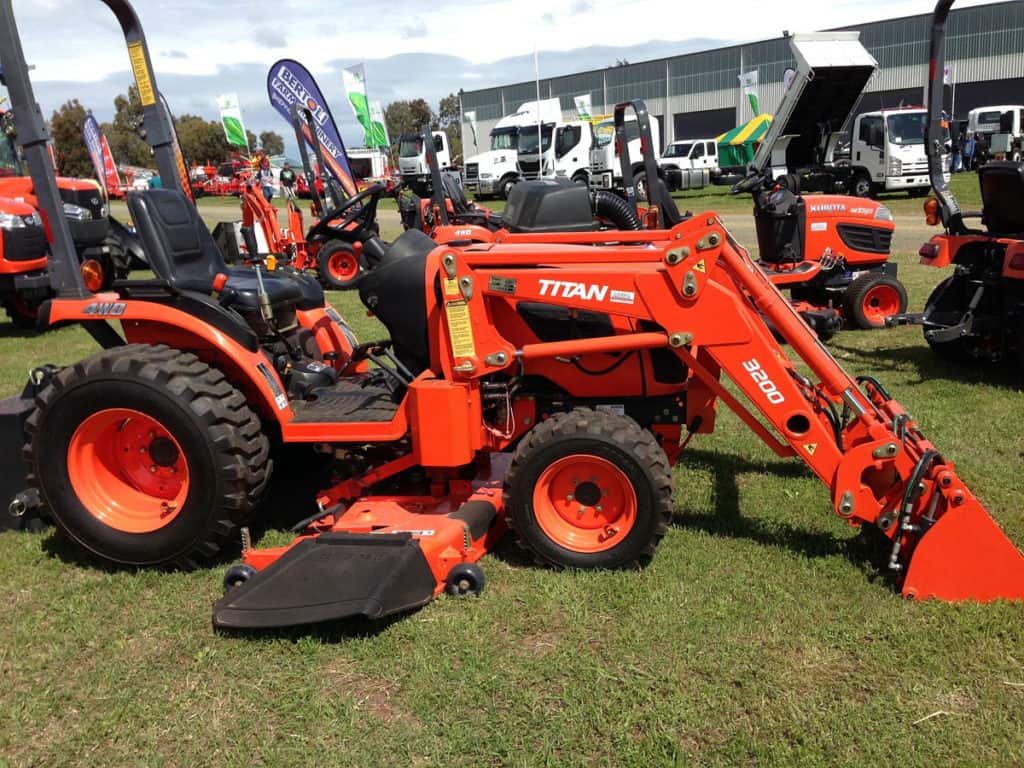
3. Brush Removal
This can be another offering that is part of the mowing and rototilling services. You could easily combine the two services.
Sometimes there are brush-type plants that can overgrow an area that a mower cannot handle. So using something like a brush hog makes more sense. From my own experience operating this implement really does a job on the heavy brush to the point where it’s unnecessary to pick anything up once it’s done.
If it’s a groomed property then raking and removing the clippings might be required. If this is the case then you’ll want a truck, trailer, or both to haul things away.
| Implement Needed For Brush Removal: 3-point standard or heavy-duty rotary cutter. |
4. Snow Removal
If you’re in a snowy area, this can be a lucrative service. You can use a front blade, back blade, and front loader.
There are also rear and front snowblower attachments that make fast work of unwanted snow from your customer’s property. This will be possibly one of the many services on your menu for people to hire you.
When offering this service, one thing to consider is to have a set of chains that will work on your tractor’s tire sizes. To help you out, here are several options for tractor tire chains on Amazon.
Also, having a 4×4 tractor would be very advantageous for this and other types of work.
| Potential Implements Needed For Snow Removal: Front or rear plow type blade, front or rear snow blower, chains, and front end loader. |
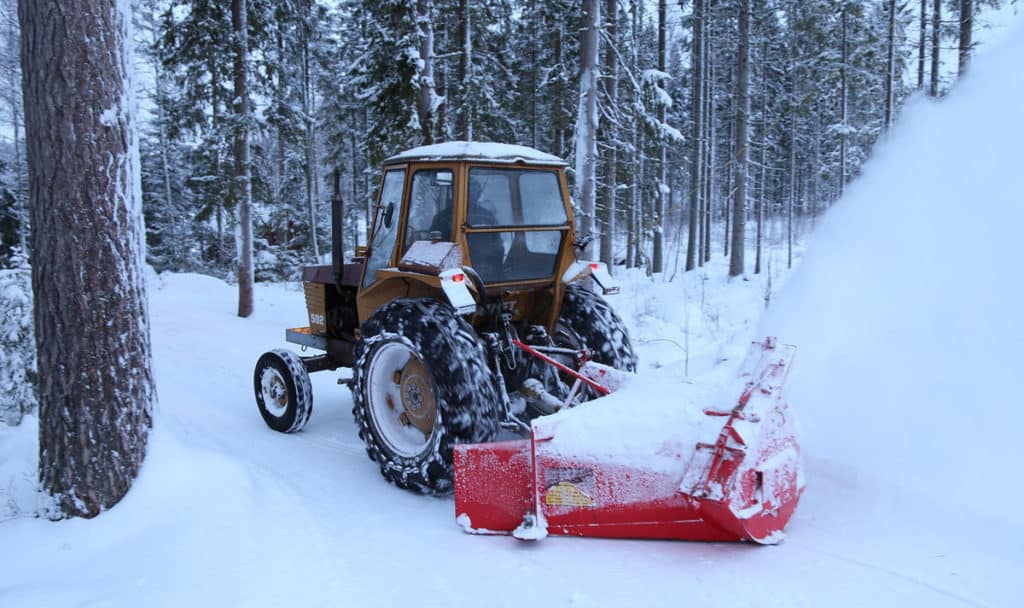
5. Garden Work
More than just rototilling is needed in order to get a garden ready for planting. Be sure you have some understanding in what’s required for gardening.
Your customers are going to look to you for advice and expect you to have the knowledge required to ensure a successful and high yielding garden. Even if all you are doing is getting the soil ready for them to do the planting.
Things the garden area might need depending on the soil and the crops being planted could consist of the following.
- Plowing helps to turn over the soil, which is performed mostly in the fall.
- Disc harrowing is another way to till the soil.
- Middle busting to create furrows before planting.
- Planting of seeds.
- Fertilizing
| Potential Implements Needed Garden Work: Tiller or disc harrow, plow, middle buster, single row seed planter, spreader, and sprayer. |
6. Driveway Maintenance
Harsh weather and time can play havoc on driveways. They can become washed out or wash boarded, which makes the ride over it difficult.
These issues are the perfect opportunity for someone with the right equipment, like a rear blade or box blade, which works great for simultaneously moving gravel and leveling.
A front loader is almost a must for moving dirt, rock, and gravel.
A landplane or chain harrow could also be used to help keep dirt or graveled driveway smooth and leveled, as well as a chain harrow.
| Implement Needed For Driveway Maintenance: Front end loader/bucket, box blade, rear grader blade, landplane. |
7. Digging Post Holes and Maintain Fencing
This type of service speaks for itself. You’ll need an auger-type post hole digger to perform this type of job with possibly varying auger sizes. Standard sizes come in 6 inches all the way up to 12″ bits.
Once the post holes are dug and the posts are set, you can also use your tractor to tension wire type fences, among other fencing tasks.
If it’s a wooden fence, use your tractor with front or rear forks to transport and hold wood material.
| Implement Needed For Digging Post Holes and Maintain Fencing: 3-point post hole auger, front-end loader, and clamp-on pallet forks. |
| TIP: The tractor’s three-point auger can also be used for setting posts for barns and other outbuildings as an additional service offering. The biggest challenge with this service, depending on the poles’ length, is how to get them into the holes and safely secured if you’re working alone.
8. Dirt or Gravel Moving
Using a rear blade or a box blade you can assist people with moving dirt from one location to another by dragging it to that point.
Another handy implement to make this type of job easier is a front end loader, along with a dumping utility trailer to use for loading the dirt or gravel to move larger quantities to a different location. Use a drawbar to attach the trailer to the tractor for pulling.
| Potential Implements And Other Items Needed For Dirt or Gravel Moving: A 3-point rear blade, box blade, front loader, three-point drawbar with a hitch receiver, and a dumping trailer. |
I use an 11 hole drawbar that looks something like this found on Amazon. Then add this drawbar stabilizer, also found on Amazon, that has a two-inch receiver, and you’re all set.
9. Backhoe Digging
Huge heeded warning in this category, make sure you’re covered well with liability insurance for this type of service.
Also, make sure you understand the local ordinances for digging below the surface in the area you’re going to dig. Use the utility or other services available near you that can tell you what’s underground before you start digging.
Once you know you’re well covered this type of work can pay well. Add a backhoe to the back of your tractor and you have the potential of charging $100 per hour or more.
Make sure you check your local, county, and state requirements before offering services using a backhoe.
Note: From my research and talking with a couple of people who have used this implement, be aware that a backhoe on the back of your tractor could potentially do serious damage to it due to the stress created.
| Implement Needed For Backhoe Digging: A Backhoe attachment. |
| TIP: A more dedicated backhoe might be a better solution, especially if this becomes a primary service offering.
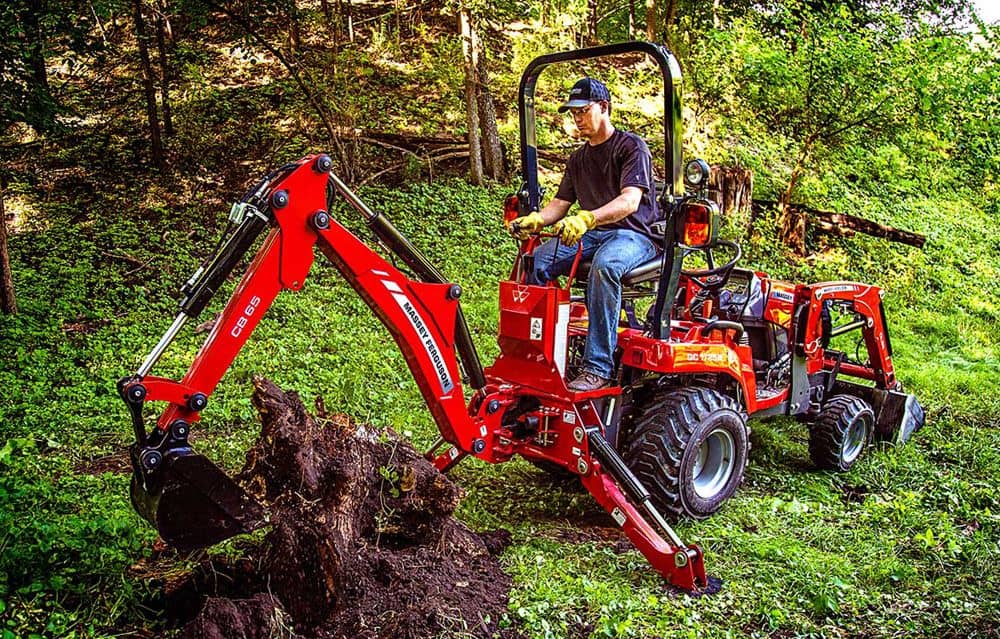
10. Raking Services
There is two types of rakes available that you could use for this service offering. The most commonly type of rake used is the landscaper rake.
These are a 3-point attachment with curved tines designed to slightly go below the surface (two inches or so) and pull up underlying objects such as rocks, roots, loose sod, sticks, and other unwanted trash you don’t want to be mixed with the soil.
While doing this the flexibility of the tines allows the soil to fall through the spacing between the tines, leaving it in its place.
The other type of rake is a pine straw rake. The tines on this type of rake are smaller in size and spaced further apart from one another. This rake is great for picking up pine needles, straw, leaves, trash, and grass from the surface, not under it.
One other need to consider is a way to haul off the collected items from your rake job.
| Implement Needed For Raking Services: A 3-point landscape or pine straw rake. |
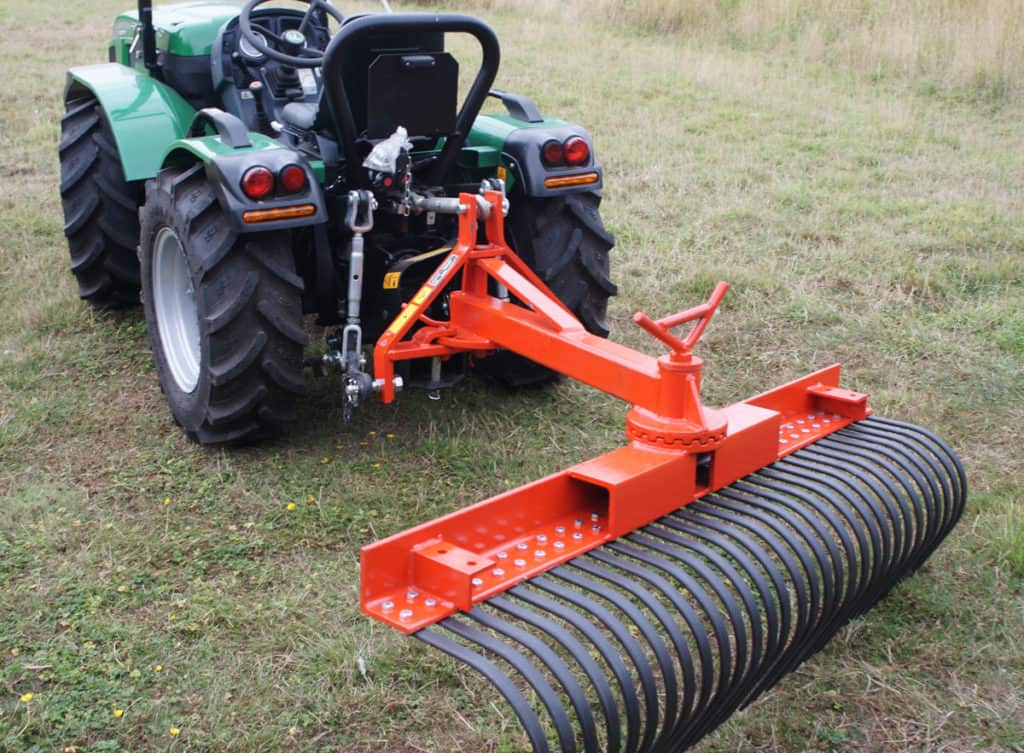
11. Spraying and Spreading Services
Sprayers associated with a tractor are larger, so you can offer all types of spraying applications— for anything from large pastures, sports fields to a golf course.
A lot of 3 point sprayers will also include a single nozzle sprayer so you can target specific areas. Spray insecticides, pesticides, and fertilizers quickly with a wide boom with nozzles.
Sprayers come in various sizes, 20 gallons all the way up to 300 gallons, but you’ll want to fit it to the tractor size you’re operating.
Most sprayers utilize the PTO on the tractor to power a pump to the sprayer. If a PTO isn’t used, then an electric pump will be supplied to do the same thing.
As an added service, it would be easy to incorporate a spreader with this service. Having the ability to spread things like fertilizer, grass seed, or other spreadable items lets your customer know that you are a full-service provider.
| PRECAUTIONARY TIP: Be sure you check with local and state agencies for any restrictions on spraying and mixing chemicals.
| Implement Needed For Spraying and Spreading Services: A 3-Point spraying system that includes a tank and boom with spray nozzles. Be aware you might also need additional nozzles depending on the type of spray you require for the job application. There are varying nozzles available. |
12. Small Farming Tasks
Offer your tractor service out to smaller farms needing some extra help with harvesting, cultivating, or general cleaning up.
- Furrow a field for planting or harvesting rooted crops such as potatoes.
- Scoop manure with a front end loader and pile up out of the way of the animals or stables.
- Disc harrow fields to cultivate the field in preparation for planting.
- Pull a small trailer or a farm wagon for feeding animals or bring in crops.
| Potential Implements Needed For Small Farming Tasks: A Front loader, plow, discs, tiller or other soil cultivators, disc plow/harrow, rake, middle buster, Hiller/furrower attachment, 3-point seed planter, and tow behind agri-sprayer. |
13. Felled Tree And Log Removal
The idea here is to help a customer cut up a fallen tree and remove it. If the tree has lumber value then it’ll be cut into short logs for removal. The rest of the woody debris of the tree is called slash or slashing.
As part of this service the slashing will also need to be managed. There are three options.
- Pile the slash where it’s located and burn it. (Check local burning regulations first.)
- Cut it up and, using a larger trailer, haul it off.
- Use a chipper/shredder to turn the slash into a mulch or other ground cover.
Once you have the slash figured out, you’ll need to do something with the logs. Here are some ideas using varying types of tractor implements.
- A simple way to remove a log is using a three-point drawbar and a choker chain or cable. Drag logs to where ever your customer wants them. Get a drawbar with a 2″ receiver at Amazon. Get a choker chain here at Amazon as well.
- If you have a three-point boom on the back of your tractor, you can lift and drag a log anywhere it needs to be moved.
- Use a front-end fork to lift logs onto a flatbed or other log-type trailer.
- Use a frontend grappler attachment for lifting and either moving or loading logs.
- Cut, buck, and split the logs into firewood using a log splitting implement.
Combine all these tasks together and you have a small tree service.
| Potential Implements Needed For Felled Tree And Log Removal: A 3-point drawbar, three-point boom, front-end loader, clamp-on bucket pallet forks or front-end forklift frame, frontend grappler, and a log splitter PTO driven. |
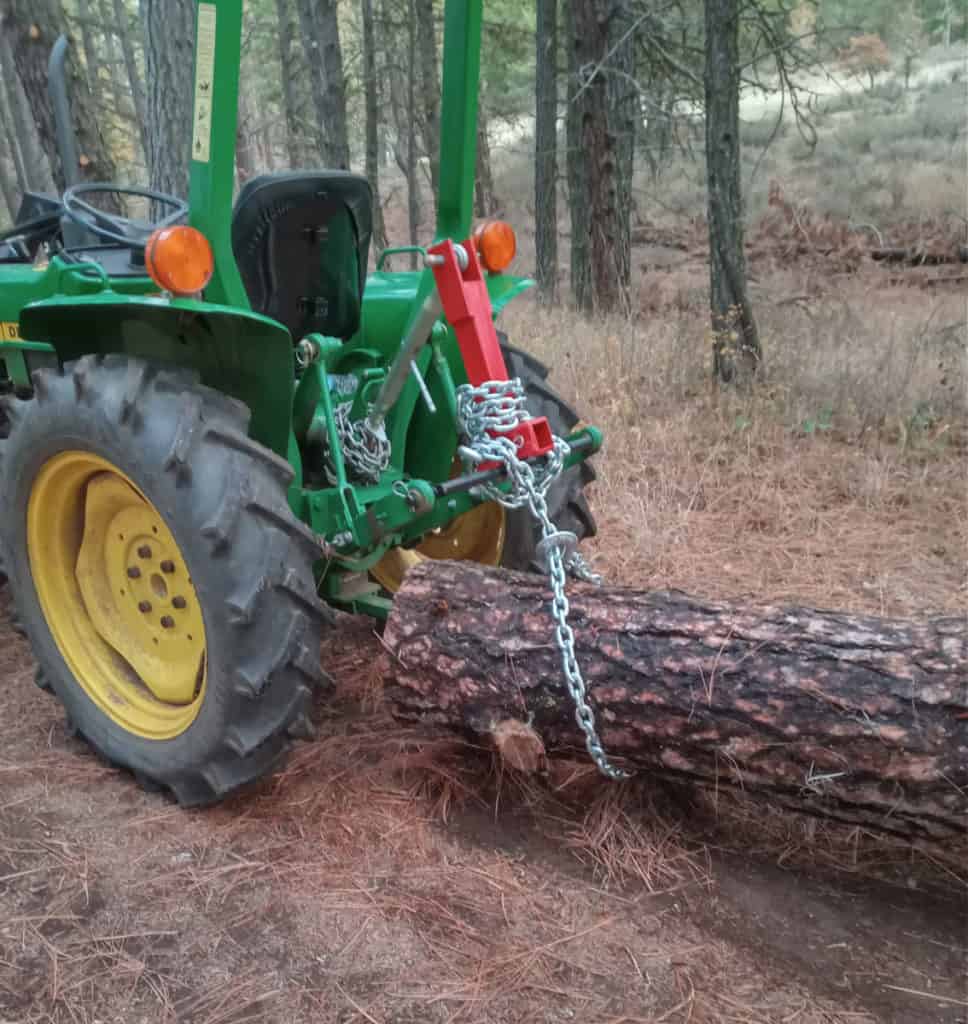
14. Lift, Haul, and Move Stuff
This could be anything from bags of feed to bales of hay or straw.
Use front or rear forks to lift pallets of items or use those same pallets as a platform to load up and move things from one point to another.
I personally use front forks that attach to my bucket for lifting logs, pushing brush, and loading a pallet for moving stuff around.
Use a boom pole to move larger items like an old piece of equipment or even possibly an old engine block.
Help folks with moving and stacking their firewood piles.
Having a ball hitch on your tractor can come in handy in an event where a customer needs to have something like a trailer or possibly an old boat on a trailer moved to a new location.
| Potential Implements Needed For Lifting, Hauling, And Moving Stuff. A pair of clamp-on pallet forks, a 3-point boom pole, and a three-point drawbar with a receiver and 2″ ball. |
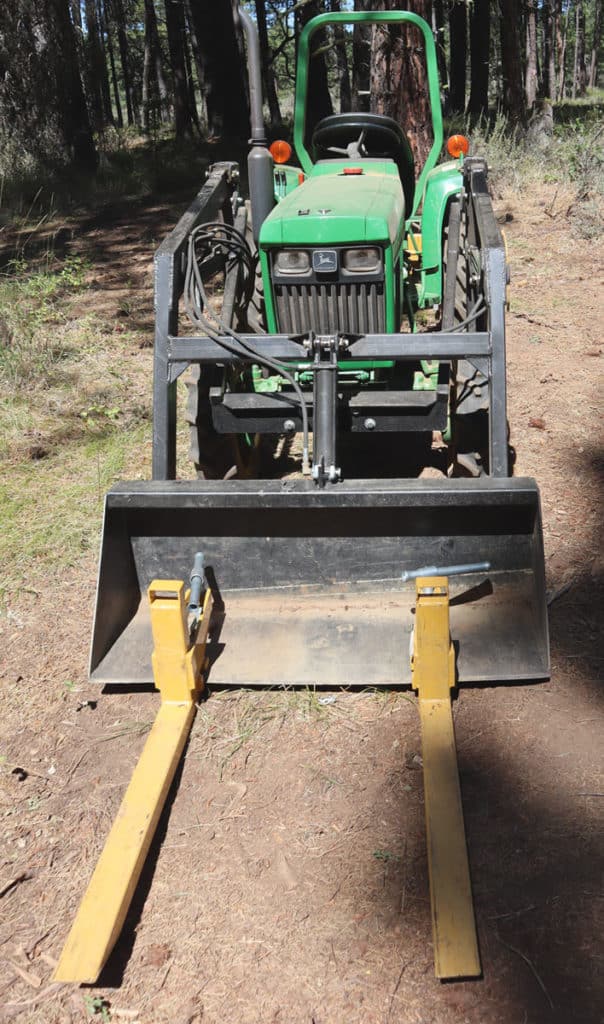
Cultivating And Growing Your Business
So once you’ve figured out what services you’re going to offer it’s time to start getting some business.
One of the best business marketing tools has always been word of mouth. When I started a couple of my businesses, I remember one way I got people’s attention was by offering something super discounted or even free.
Maybe this will work for you as well by simply offering a couple of your neighbors to mow down some annoying weeds or grass in their yard or a pasture.
If you do an outstanding job, that neighbor will talk to other people, and eventually, that good deed will pay you back.
Another way to turn up some business is to talk and leave your business card with your local tractor dealers and your farm and implement stores.
Start with the dealer you bought your tractor from to see if they would be willing to refer some business your way. In return, you can buy your tractor items exclusively from them.
Other businesses such as farm and co-op stores might have a bulletin board where people post help wanted notifications for services they need. You could also hang a couple of small posters yourself on those same boards listing the various services you can provide.
Potential Requirements
Some states could classify some of the services in this article as either landscaping or construction services. Be sure you check your local and state definitions to see if you’ll be required to have a contractor’s, landscaper’s, or another professional or business license.
This means you have to pass a test that tells everyone that you are a legit operator and that you know what you’re doing.
Depending on your plans with your tractor, even if your area does not require a license, it could still be a good thing to obtain. Doing so will let your potential customers know that you are serious about what you offer and that you possess the proper skills and experience. Not to mention giving you confidence and peace of mind.
Final Thoughts
As you can see, there are many ways to earn money using your tractor and implements.
As mentioned earlier, these are not everything as there are many other types of implements and attachments available for your tractor to earn income.
Go to any tractor dealership or farm store, and you’ll see the vast number of varying implements available for tractors.
